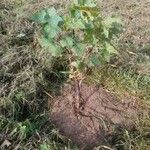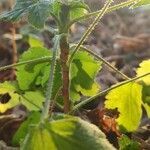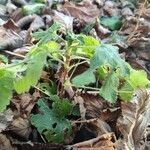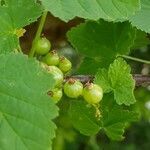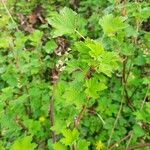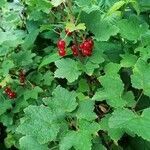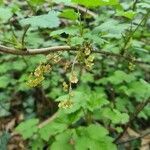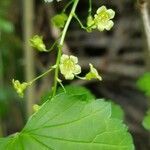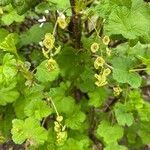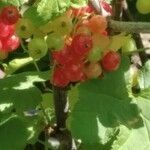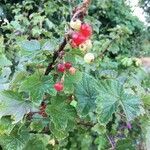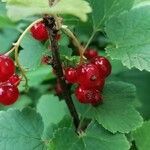Plants (not strong-smelling), 0.5-1.5 m. Stems erect, nearly glabrous, crisped-puberulent (somewhat stipitate-glandular on young growth); spines at nodes absent; prickles on internodes absent. Leaves: petiole 3-6 cm, glabrous; blade suborbiculate, 5-lobed, cleft 1/3-1/2 to midrib, 2.5-4.5 cm, base truncate to cordate, surfaces not glandular, sparsely hairy on veins abaxially, glabrous adaxially, lobes broadly ovate-triangular, margins bicrenate-serrate, apex acute. Inflorescences ascending to pendent, 8-20-flowered racemes, 2-6 cm, axis glabrous, not glandular, flowers evenly spaced. Pedicels jointed, to 6 mm, glabrous, not glandular; bracts broadly ovate, 0.5-1 mm, glabrous. Flowers: hypanthium ochroleucous or greenish, saucer-shaped, 1 mm, glabrous; sepals nearly overlapping, spreading (revolute at tips), green or greenish brown, broadly deltate-ovate (abruptly narrowed to slender base), 2-2.5 mm; petals widely separated, erect, cream to pinkish, cuneate-flabellate, not conspicuously revolute or inrolled, 0.3-1 mm; nectary disc prominent, green, raised, 5-angled, covering top of ovary; stamens nearly as long as petals; filaments linear, 0.2-0.3 mm, glabrous; anthers white, dumbbell-shaped, 0.2-0.3 mm (broader than long), apex with U-shaped depression, (anther sacs distinctly separated by connective as broad as sac); ovary glabrous; styles connate 1/2 their lengths, 1+ mm, glabrous. Berries sour, bright red, globose, 6-10 mm, glabrous.
More
Unarmed, deciduous, scarcely aromatic shrub usually 0.5-1.5 m high; branches and shoots erect, slightly hairy when young. Lvs plicately folded in bud, with petioles to c. 8 cm long, slightly clasping at base; lamina broadly deltoid, 6-11 × 8-13 cm, often smaller on upper part of flowering stems, deeply palmately lobed, with 3-5 coarsely toothed, deltoid lobes, glabrate, dull and slightly rugose above, slightly to moderately hairy beneath, especially on veins; glands 0; base cordate or subcordate. Racemes pendent, usually 10-20-flowered; fls not fragrant. Hypanthium c. 1 mm diam., broadly campanulate, green, glabrous. Sepals c. 2-2.5 mm long, broadly obcuneate, green, reflexed at anthesis. Petals 0.5-0.7 mm long, ± rectangular and slightly obovate, green. Filaments c. 0.5 mm long. Fr. 5-10 mm diam., globose, red and shining, occasionally white, translucent, glabrous; flesh sweet.
A small bushy shrub. It grows 1.5 m tall. It spreads 1.5-2 m wide. It loses its leaves during the year. The stems are smooth. The leaves have 3-5 lobes. They are 10 cm across. They can be downy underneath. The flowers are green with some red colouring. They can be upright or hang down. The fruit allow light through.
Fruit can be eaten fresh. They are also used for fruit drinks. They are also used in jams and jellies, puddings, pies, tarts, syrups and sauces. They are also made into wines. The flowers are used for tea.
